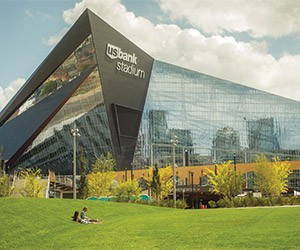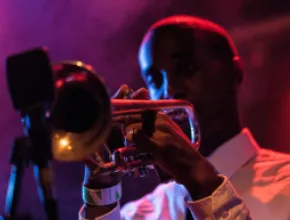Minneapolis and Saint Paul are as diverse and vibrant as Midwestern meetings metros get. Together, they mix Upper Midwest hospitality with urbane beauty, big corporate headquarters with tiny gourmet restaurants, and plentiful meeting spaces with precious art and artifacts in dozens of museums and galleries.
They are Minnesota's commercial and political capitals, respectively, and face each other across the Mississippi River. Though their combined population is not quite 700,000, the Twin Cities anchor a metropolitan area of nearly 3.5 million—meaning roughly two-thirds of Minnesota's population lives just a short drive from either of the two downtowns.
The cities began life around the gigantic S-curve the Mississippi makes as it intersects the Minnesota River, but when Saint Paul was declared the capital of the Minnesota Territory in 1849, the die was cast: Saint Paul would rule the political sphere while Minneapolis would become the state's commercial hub. This split has persisted for 150 years even as their combined commercial appeal and political power have kept the metro region the bulls-eye of Minnesota's business, politics and culture.
Minneapolis
Minneapolis first grew as a site for processing Minnesota's world-beating grain harvests, much of which arrived here to be turned into flour and shipped down the Mississippi. The river remains a big part of the city's collective consciousness, says Melvin Tennant, president and CEO of Meet Minneapolis.
"A lot of people don't realize the Mississippi River runs through downtown, so there's an effort to reinvigorate the riverfront area. The very name Minneapolis speaks to water and lakes and we want to recapture that," Tennant says, since "Minneapolis" combines the Dakota Sioux word for "water"—mni—with the Greek term for "city"—polis.
Today, Minneapolis has diversified into other areas, including healthcare and finance, and is the headquarters for Fortune 500 corporations such as U.S. Bancorp, Thrivent Financial for Lutherans, retailing giant Target, and electricity and natural-gas powerhouse Xcel Energy. Traditionally nicknamed the Mill City, Minneapolis now styles itself the City of Lakes for the two dozen bodies of water that stretch out west of downtown like an enormous blue necklace.
The impression you get approaching Minneapolis by car, especially at night, is of a glowing modern city dominated by skyscrapers and big stadiums such as Target Field, where the Minnesota Twins play. Outside the urban core, one-sixth of the city is parkland—all those lakes serve as year-round outdoor playgrounds—and Minneapolis' Grand Scenic Byway include 52 miles of combined bike, pedestrian and auto paths.
Equally important is a cultural landscape that is highlighted by one of America's most athletic populations, the honor of being America's most-literate city in 2007 (with neighboring Saint Paul taking third place) and, remarkably, per-capita theater attendance that's second only to New York.
"It has happened organically," Tennant says. "We have a tremendous creative class in Minneapolis, and that manifests itself in the theater and other cultural institutions—and people come here now for instruction."
Downtown offers seven miles of enclosed skyways that shield pedestrians from inclement weather as they move from building to building—including about 3,500 of the city's 6,000 hotel rooms. In addition, Minneapolis is served by a freeway system and both light rail and commuter rail lines, which connect both the Minneapolis-Saint Paul Airport and Mall of America to downtown.
The city's meeting facilities range from the centrally located Minneapolis Convention Center, with 475,000 square feet of exhibit space spread over 87 rooms and a 3,433-seat auditorium, to the sleek, modern Walker Art Center, whose spaces hold hundreds and look out onto busy Hennepin Avenue and the Minneapolis Sculpture Garden, to the reception-ready, five-story atrium at the Cesar Pelli-designed Minneapolis Central Library.
Top meetings-friendly hotel properties include the Crowne Plaza Northstar, Hilton Minneapolis, Hyatt Regency Minneapolis, Minneapolis Marriott City Center, Millennium Hotel Minneapolis, Radisson Plaza Hotel Minneapolis and Westin Minneapolis.
Saint Paul
Situated just across the Mississippi from Minneapolis-Saint Paul International Airport, Saint Paul's skyline features a series of modest skyscrapers as well as the Cathedral of Saint Paul and the Minneapolis State Capitol building, with beautiful domes dominating downtown from either end of John Ireland Boulevard.
Saint Paul recently gained the national spotlight by hosting the Republican National Convention in 2008 and is now watching as native son and former Minnesota Gov. Tim Pawlenty contemplates a presidential run in 2012.
Of course, as the state capital you'd expect Saint Paul to be focused on politics, but even in non-election years there's a lot more going on thanks to the major presence of companies such as Ecolab, Ford Motor Co., sports retailer Gander Mountain and 3M Corporation (although the latter is technically located in adjacent Maplewood).
Non-political events are a big part of the city's meetings business, according to Adam Johnson, vice president of marketing at the Saint Paul Convention and Visitors Authority, who notes that the city recently hosted 15,000 visitors for the U.S. collegiate hockey championship at the Xcel Energy Center and will host USA Gymnastics' premier event, the Visa Championships, this August.
Saint Paul will also host the NHL Entry Draft at the Excel Energy Centre this year, drawing about 500 media along with 15,000 fans.
"It is a sports-related year," Johnson confesses, noting that even the World Senior Curling Championships has chosen Saint Paul, but that the city has a unified campaign to make sure the word gets out about all events, not just the athletic ones.
Meetings properties here include Crowne Plaza Saint Paul Riverfront, Embassy Suites Downtown Saint Paul, Saint Paul Hotel and the boutique Hotel 340, located in the landmark University Club of Saint Paul building.
The Grand Avenue area continues to be one of the city's hippest, and preparations are ongoing for this year's Grand Old Day, an annual festival of shops and restaurants in the area that takes place each June.
Cultural attractions include the Science Museum of Minnesota, which will run its highly successful Tutankhamen: The Golden King and the Great Pharaohs exhibit through September, as well as a plethora of annual festivals, including the Twin Cities Jazz Festival in Mears Park.
Minneapolis Northwest
The Minneapolis Northwest area includes Brooklyn Park, Brooklyn Center and Maple Grove, which this year celebrate their first quarter-century of joint marketing. The region just rebranded from Visit Minneapolis North to Minneapolis Northwest. The three cities have 2,400 hotel rooms and hundreds of restaurants between them, with close proximity to the Minneapolis-Saint Paul Airport and the area's major downtowns.
Brooklyn Park features the Edinburgh USA Golf Course, while the highly caffeinated may recognize Brooklyn Center as the headquarters of Caribou Coffee. Maple Grove emphasizes the enormous amount of retail at the Shoppes at Arbor Lakes, as well as a Boston Scientific research and development facility.
Meetings-friendly properties here include the Crowne Plaza Minneapolis North, Earle Brown Heritage Center and adjacent Embassy Suites Minneapolis Brooklyn Center, Northland Inn Hotel & Conference Center and Ramada Minneapolis Northwest-Brooklyn Park.
Bloomington
Bloomington can accurately be described as the place where Minnesota—and consumers from the other 49 states—shops, since it gets something like 40 million visitors each year. Its strategic location across two highways and a stone's throw from the Minneapolis-Saint Paul International Airport help bring in all those shoppers, as do continuing efforts to improve the property, including the Waterpark of America, the largest indoor waterpark in Minnesota, which connects directly to the meetings-friendly Radisson Mall of America.
All those visitors have inspired many more hoteliers to set up shop here, of course, and other meetings-friendly properties include the Crowne Plaza Bloomington, Embassy Suites Bloomington, Hilton Minneapolis/Saint Paul Airport, Minneapolis Airport Marriott, Sheraton Bloomington Hotel-Minneapolis South and Sofitel Minneapolis.
West of Bloomington, the IACC-certified Oak Ridge Hotel & Conference Center in Chaska is also a popular choice for groups.
Beyond the immediate Mall of America area, visitors may enjoy visiting the Japanese Garden at Normandale Community College, which features a painstakingly created waterfall, pond, bridge and beautifully manicured gardens, or the Minnesota Valley Wildlife Refuge, which features a visitor center with 8,000 square feet of meeting space.
Eagan
Just across the Minnesota River from Bloomington, Eagan also trades on its proximity to Minneapolis-Saint Paul International Airport and the Mall of America and adds 15 hotels, the Minnesota Zoological Gardens, the Cascade Bay outdoor waterpark and hiking and kayaking opportunities along the river to the metropolitan area's mix. MFMA
Paul D. Kretkowski writes frequently about travel, food and sports. He is also the founder of Beacon, a blog about foreign policy.






